YAMAHA YZF600 2001 Service Manual
Manufacturer: YAMAHA, Model Year: 2001, Model line: YZF600, Model: YAMAHA YZF600 2001Pages: 114, PDF Size: 12.39 MB
Page 41 of 114
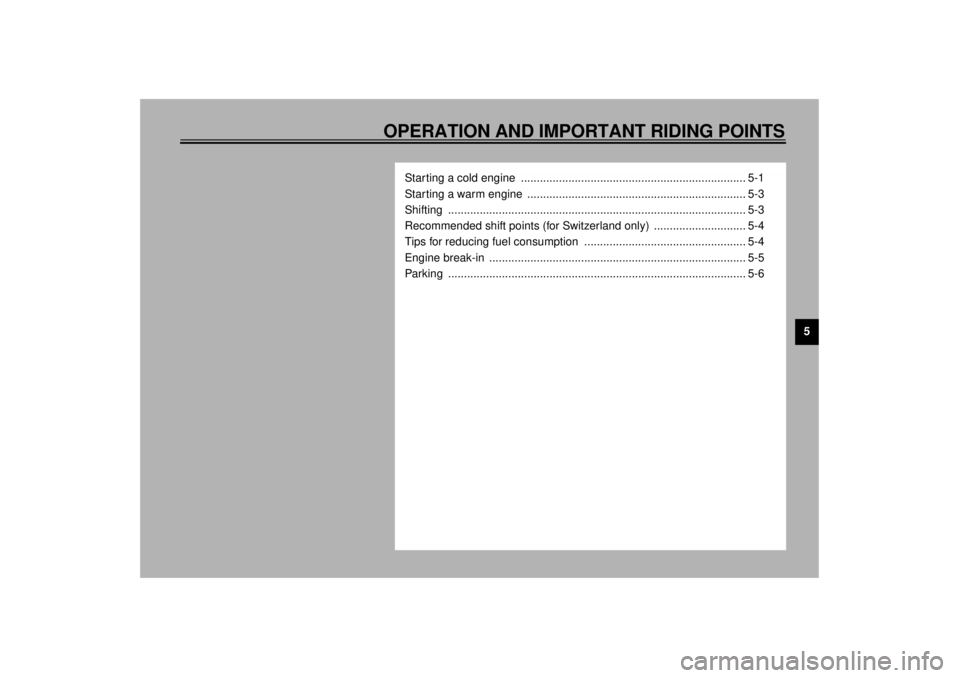
OPERATION AND IMPORTANT RIDING POINTS
5
Starting a cold engine ....................................................................... 5-1
Starting a warm engine ..................................................................... 5-3
Shifting .............................................................................................. 5-3
Recommended shift points (for Switzerland only) ............................. 5-4
Tips for reducing fuel consumption ................................................... 5-4
Engine break-in ................................................................................. 5-5
Parking .............................................................................................. 5-6
E_4tv.book Page 1 Wednesday, October 4, 2000 2:15 PM
Page 42 of 114
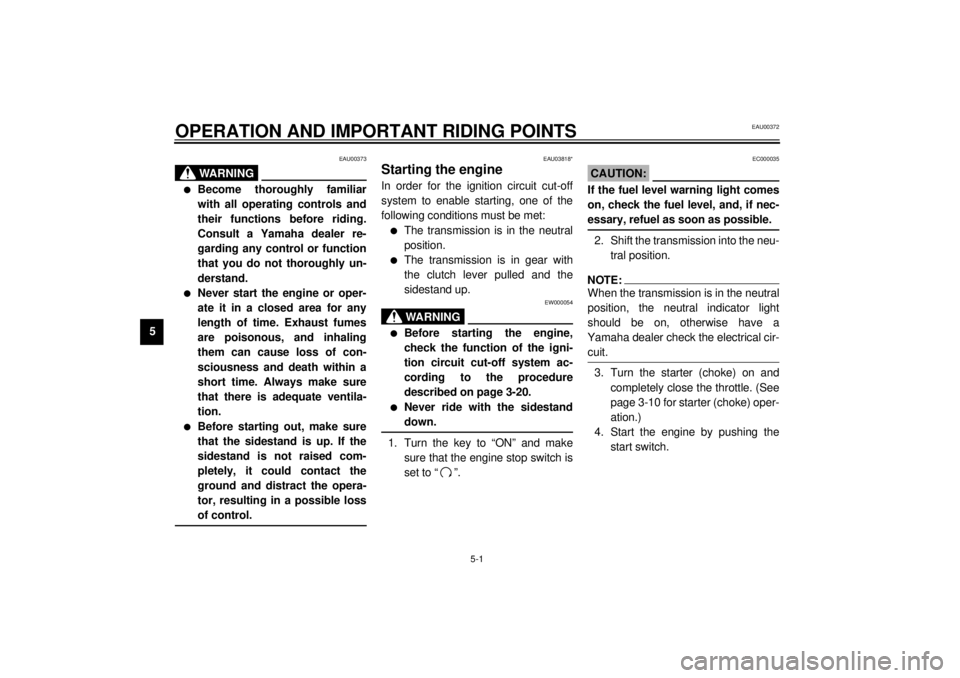
5-1
5
EAU00372
5-OPERATION AND IMPORTANT RIDING POINTS
EAU00373
WARNING
_ l
Become thoroughly familiar
with all operating controls and
their functions before riding.
Consult a Yamaha dealer re-
garding any control or function
that you do not thoroughly un-
derstand.
l
Never start the engine or oper-
ate it in a closed area for any
length of time. Exhaust fumes
are poisonous, and inhaling
them can cause loss of con-
sciousness and death within a
short time. Always make sure
that there is adequate ventila-
tion.
l
Before starting out, make sure
that the sidestand is up. If the
sidestand is not raised com-
pletely, it could contact the
ground and distract the opera-
tor, resulting in a possible loss
of control.
_
EAU03818*
Starting the engine In order for the ignition circuit cut-off
system to enable starting, one of the
following conditions must be met:l
The transmission is in the neutral
position.
l
The transmission is in gear with
the clutch lever pulled and the
sidestand up.
EW000054
WARNING
_ l
Before starting the engine,
check the function of the igni-
tion circuit cut-off system ac-
cording to the procedure
described on page 3-20.
l
Never ride with the sidestand
down.
_1. Turn the key to “ON” and make
sure that the engine stop switch is
set to “ ”.
EC000035
CAUTION:_ If the fuel level warning light comes
on, check the fuel level, and, if nec-
essary, refuel as soon as possible. _2. Shift the transmission into the neu-
tral position.NOTE:_ When the transmission is in the neutral
position, the neutral indicator light
should be on, otherwise have a
Yamaha dealer check the electrical cir-
cuit. _3. Turn the starter (choke) on and
completely close the throttle. (See
page 3-10 for starter (choke) oper-
ation.)
4. Start the engine by pushing the
start switch.
E_4tv.book Page 1 Wednesday, October 4, 2000 2:15 PM
Page 43 of 114
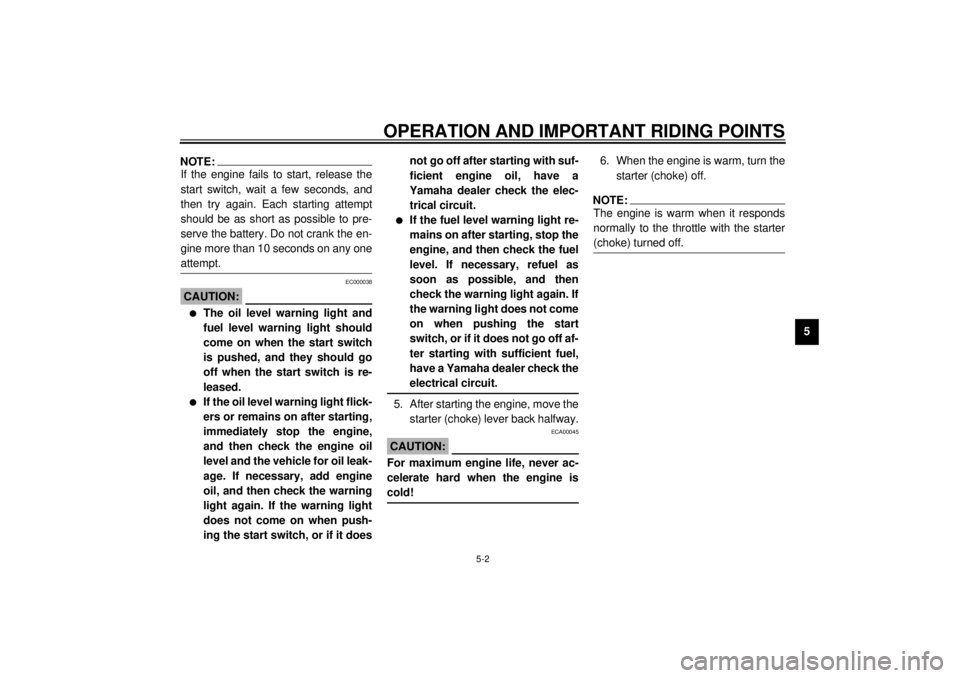
OPERATION AND IMPORTANT RIDING POINTS
5-2
5
NOTE:_ If the engine fails to start, release the
start switch, wait a few seconds, and
then try again. Each starting attempt
should be as short as possible to pre-
serve the battery. Do not crank the en-
gine more than 10 seconds on any one
attempt. _
EC000038
CAUTION:_ l
The oil level warning light and
fuel level warning light should
come on when the start switch
is pushed, and they should go
off when the start switch is re-
leased.
l
If the oil level warning light flick-
ers or remains on after starting,
immediately stop the engine,
and then check the engine oil
level and the vehicle for oil leak-
age. If necessary, add engine
oil, and then check the warning
light again. If the warning light
does not come on when push-
ing the start switch, or if it doesnot go off after starting with suf-
ficient engine oil, have a
Yamaha dealer check the elec-
trical circuit.
l
If the fuel level warning light re-
mains on after starting, stop the
engine, and then check the fuel
level. If necessary, refuel as
soon as possible, and then
check the warning light again. If
the warning light does not come
on when pushing the start
switch, or if it does not go off af-
ter starting with sufficient fuel,
have a Yamaha dealer check the
electrical circuit.
_5. After starting the engine, move the
starter (choke) lever back halfway.
ECA00045
CAUTION:_ For maximum engine life, never ac-
celerate hard when the engine is
cold! _
6. When the engine is warm, turn the
starter (choke) off.NOTE:_ The engine is warm when it responds
normally to the throttle with the starter
(choke) turned off. _
E_4tv.book Page 2 Wednesday, October 4, 2000 2:15 PM
Page 44 of 114
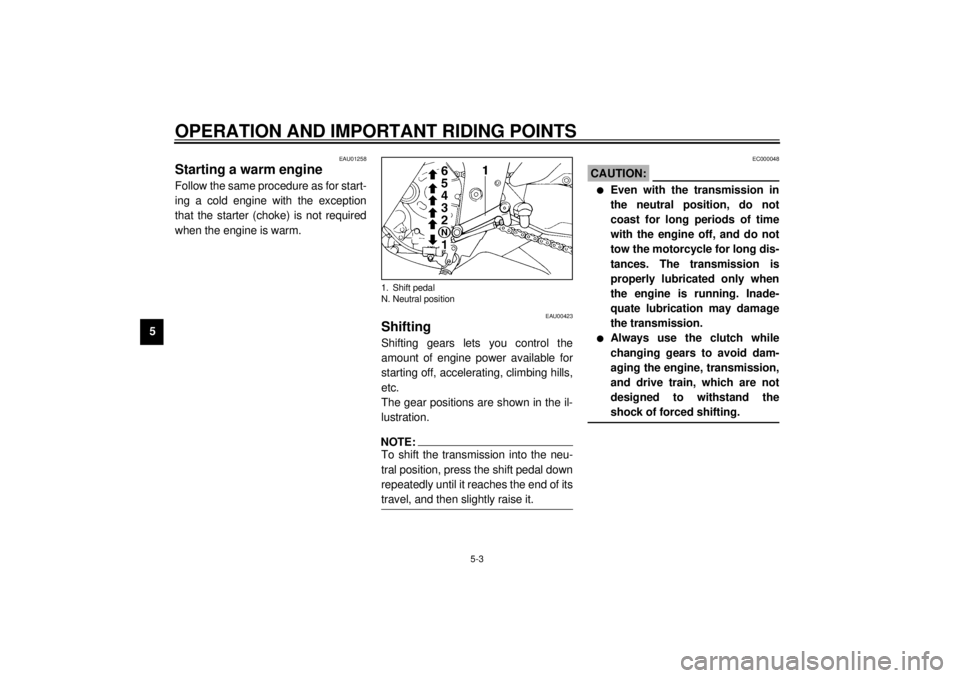
OPERATION AND IMPORTANT RIDING POINTS
5-3
5
EAU01258
Starting a warm engine Follow the same procedure as for start-
ing a cold engine with the exception
that the starter (choke) is not required
when the engine is warm.
EAU00423
Shifting Shifting gears lets you control the
amount of engine power available for
starting off, accelerating, climbing hills,
etc.
The gear positions are shown in the il-
lustration.NOTE:_ To shift the transmission into the neu-
tral position, press the shift pedal down
repeatedly until it reaches the end of its
travel, and then slightly raise it. _
EC000048
CAUTION:_ l
Even with the transmission in
the neutral position, do not
coast for long periods of time
with the engine off, and do not
tow the motorcycle for long dis-
tances. The transmission is
properly lubricated only when
the engine is running. Inade-
quate lubrication may damage
the transmission.
l
Always use the clutch while
changing gears to avoid dam-
aging the engine, transmission,
and drive train, which are not
designed to withstand the
shock of forced shifting.
_
1. Shift pedal
N. Neutral position
E_4tv.book Page 3 Wednesday, October 4, 2000 2:15 PM
Page 45 of 114

OPERATION AND IMPORTANT RIDING POINTS
5-4
5
EAU02937
Recommended shift points
(for Switzerland only) The recommended shift points during
acceleration are shown in the table be-
low.CF-02ENOTE:_ When shifting down two gears at a
time, reduce the speed accordingly
(e.g., down to 35 km/h when shifting
from 5th to 3rd gear). _
EAU00424
Tips for reducing fuel
consumption Fuel consumption depends largely on
your riding style. Consider the following
tips to reduce fuel consumption:l
Thoroughly warm up the engine.
l
Turn the starter (choke) off as
soon as possible.
l
Shift up swiftly, and avoid high en-
gine speeds during acceleration.
l
Do not rev the engine while shift-
ing down, and avoid high engine
speeds with no load on the engine.
l
Turn the engine off instead of let-
ting it idle for an extended length
of time (e.g., in traffic jams, at traf-
fic lights or at railroad crossings).
Shift point
(km/h)
1st®2nd
2nd®3rd
3rd®4th
4th®5th
5th®6th20
30
40
50
60
E_4tv.book Page 4 Wednesday, October 4, 2000 2:15 PM
Page 46 of 114
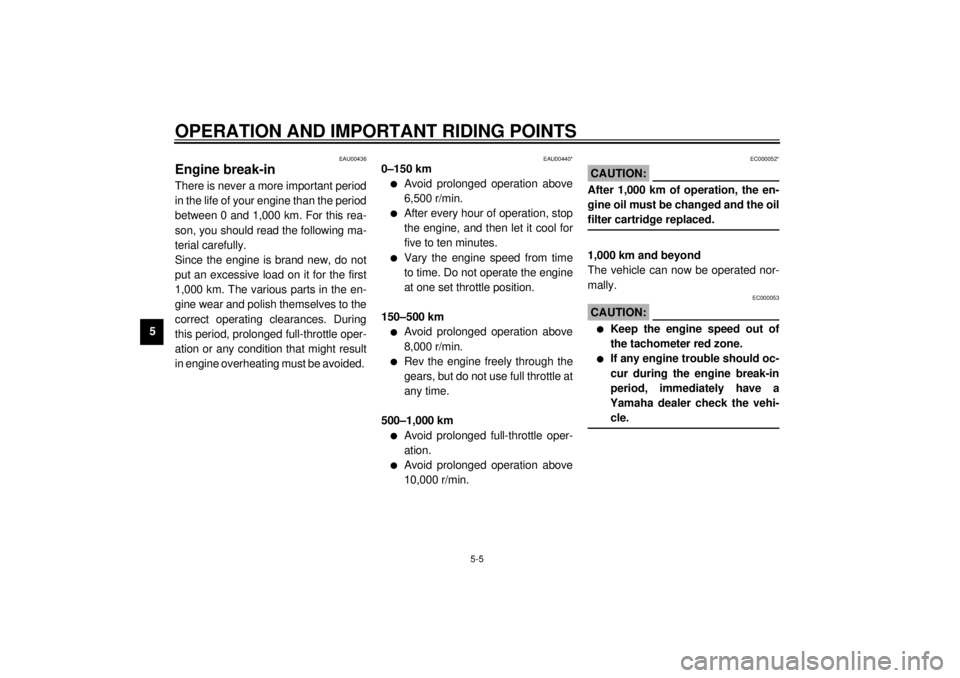
OPERATION AND IMPORTANT RIDING POINTS
5-5
5
EAU00436
Engine break-in There is never a more important period
in the life of your engine than the period
between 0 and 1,000 km. For this rea-
son, you should read the following ma-
terial carefully.
Since the engine is brand new, do not
put an excessive load on it for the first
1,000 km. The various parts in the en-
gine wear and polish themselves to the
correct operating clearances. During
this period, prolonged full-throttle oper-
ation or any condition that might result
in engine overheating must be avoided.
EAU00440*
0–150 kml
Avoid prolonged operation above
6,500 r/min.
l
After every hour of operation, stop
the engine, and then let it cool for
five to ten minutes.
l
Vary the engine speed from time
to time. Do not operate the engine
at one set throttle position.
150–500 km
l
Avoid prolonged operation above
8,000 r/min.
l
Rev the engine freely through the
gears, but do not use full throttle at
any time.
500–1,000 km
l
Avoid prolonged full-throttle oper-
ation.
l
Avoid prolonged operation above
10,000 r/min.
EC000052*
CAUTION:_ After 1,000 km of operation, the en-
gine oil must be changed and the oil
filter cartridge replaced. _1,000 km and beyond
The vehicle can now be operated nor-
mally.
EC000053
CAUTION:_ l
Keep the engine speed out of
the tachometer red zone.
l
If any engine trouble should oc-
cur during the engine break-in
period, immediately have a
Yamaha dealer check the vehi-
cle.
_
E_4tv.book Page 5 Wednesday, October 4, 2000 2:15 PM
Page 47 of 114
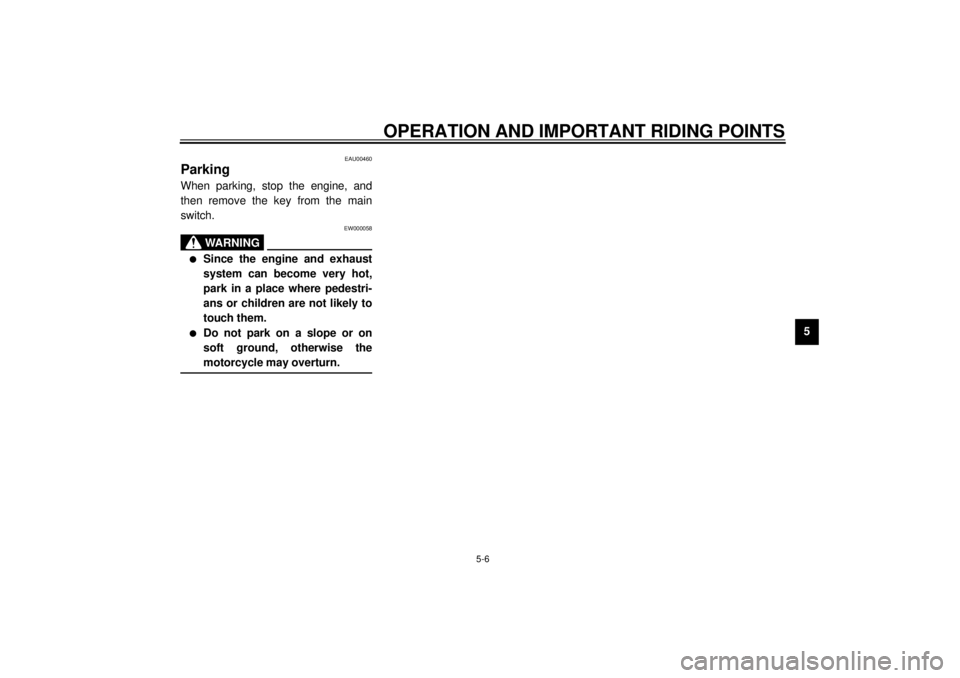
OPERATION AND IMPORTANT RIDING POINTS
5-6
5
EAU00460
Parking When parking, stop the engine, and
then remove the key from the main
switch.
EW000058
WARNING
_ l
Since the engine and exhaust
system can become very hot,
park in a place where pedestri-
ans or children are not likely to
touch them.
l
Do not park on a slope or on
soft ground, otherwise the
motorcycle may overturn.
_
E_4tv.book Page 6 Wednesday, October 4, 2000 2:15 PM
Page 48 of 114

E_4tv.book Page 7 Wednesday, October 4, 2000 2:15 PM
Page 49 of 114
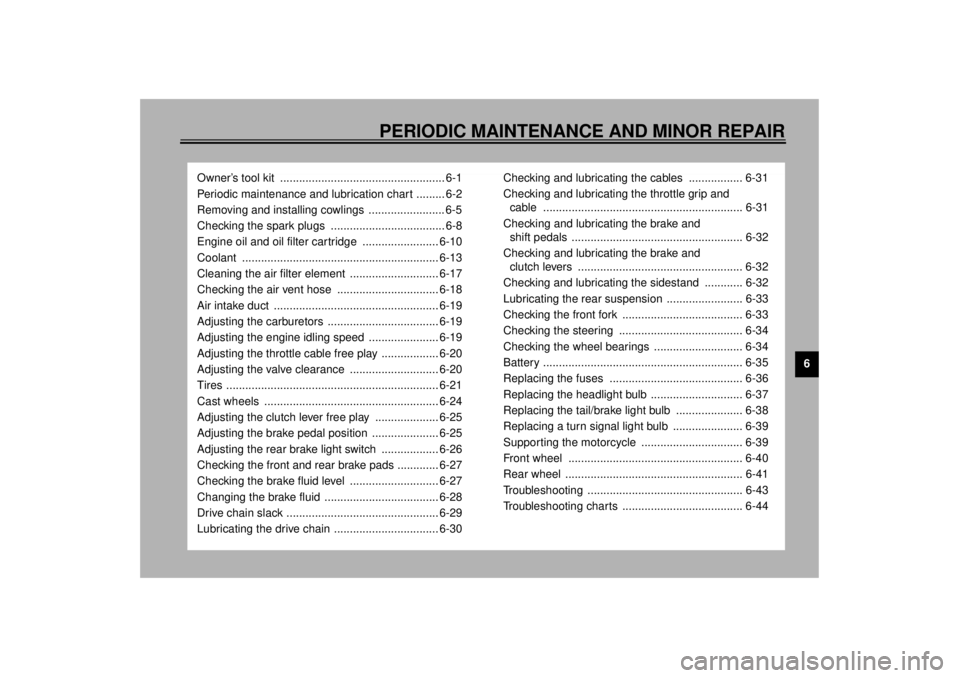
6
PERIODIC MAINTENANCE AND MINOR REPAIR
Owner’s tool kit .................................................... 6-1
Periodic maintenance and lubrication chart ......... 6-2
Removing and installing cowlings ........................ 6-5
Checking the spark plugs .................................... 6-8
Engine oil and oil filter cartridge ........................ 6-10
Coolant .............................................................. 6-13
Cleaning the air filter element ............................ 6-17
Checking the air vent hose ................................ 6-18
Air intake duct .................................................... 6-19
Adjusting the carburetors ................................... 6-19
Adjusting the engine idling speed ...................... 6-19
Adjusting the throttle cable free play .................. 6-20
Adjusting the valve clearance ............................ 6-20
Tires ................................................................... 6-21
Cast wheels ....................................................... 6-24
Adjusting the clutch lever free play .................... 6-25
Adjusting the brake pedal position ..................... 6-25
Adjusting the rear brake light switch .................. 6-26
Checking the front and rear brake pads ............. 6-27
Checking the brake fluid level ............................ 6-27
Changing the brake fluid .................................... 6-28
Drive chain slack ................................................ 6-29
Lubricating the drive chain ................................. 6-30Checking and lubricating the cables ................. 6-31
Checking and lubricating the throttle grip and
cable ............................................................... 6-31
Checking and lubricating the brake and
shift pedals ...................................................... 6-32
Checking and lubricating the brake and
clutch levers .................................................... 6-32
Checking and lubricating the sidestand ............ 6-32
Lubricating the rear suspension ........................ 6-33
Checking the front fork ...................................... 6-33
Checking the steering ....................................... 6-34
Checking the wheel bearings ............................ 6-34
Battery ............................................................... 6-35
Replacing the fuses .......................................... 6-36
Replacing the headlight bulb ............................. 6-37
Replacing the tail/brake light bulb ..................... 6-38
Replacing a turn signal light bulb ...................... 6-39
Supporting the motorcycle ................................ 6-39
Front wheel ....................................................... 6-40
Rear wheel ........................................................ 6-41
Troubleshooting ................................................. 6-43
Troubleshooting charts ...................................... 6-44
E_4tv.book Page 1 Wednesday, October 4, 2000 2:15 PM
Page 50 of 114

6-1
6
EAU00462
6-PERIODIC MAINTENANCE AND MINOR REPAIR
EAU00464
Safety is an obligation of the owner.
Periodic inspection, adjustment and lu-
brication will keep your vehicle in the
safest and most efficient condition pos-
sible. The most important points of in-
spection, adjustment, and lubrication
are explained on the following pages.
The intervals given in the periodic
maintenance and lubrication chart
should be simply considered as a gen-
eral guide under normal riding condi-
tions. However, DEPENDING ON THE
WEATHER, TERRAIN, GEOGRAPHI-
CAL LOCATION, AND INDIVIDUAL
USE, THE MAINTENANCE INTER-
VALS MAY NEED TO BE SHORT-
ENED.
EW000060
WARNING
_ If you are not familiar with motor-
cycle maintenance work, have a
Yamaha dealer do it for you. _
EAU03758
Owner’s tool kit The owner’s tool kit is located under
the seat. (See page 3-11 for seat re-
moval and installation procedures.)
The service information included in this
manual and the tools provided in the
owner’s tool kit are intended to assist
you in the performance of preventive
maintenance and minor repairs. How-
ever, additional tools such as a torque
wrench may be necessary to perform
certain maintenance work correctly.
NOTE:_ If you do not have the tools or experi-
ence required for a particular job, have
a Yamaha dealer perform it for you. _
EW000063
WARNING
_ Modifications not approved by
Yamaha may cause loss of perfor-
mance and render the vehicle un-
safe for use. Consult a Yamaha
dealer before attempting any chang-
es. _
1. Owner’s tool kit
E_4tv.book Page 1 Wednesday, October 4, 2000 2:15 PM